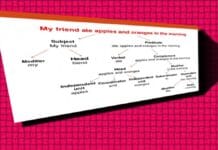In Syntactic Structures, Chomsky claims that one of the main reasons for preferring a transformational grammar to a phrase structure grammar is that the former is, in a certain sense, simpler than the latter. In his later publications, Chomsky gives responsibly more weight to the argument that transformational grammar reflects better the intuitions of the native speaker and is semantically more revealing than phrase structure grammar.
The deficiencies of phrase structure grammar regarding the generation of corresponding active and passive sentences in English has been illustrated.
E.g., The man hit the ball and The ball was hit by the man.
It is already seen how active sentences are generated in a phrase structure grammar, and we could easily add further rules to the system to generate passive sentences. What cannot be represented within the framework of a phrase structure grammar is the fact that pairs of sentences like The man hit the ball and The ball was hit by the man are ‘felt’ by native speakers to be related or to belong together in some way and have the same or a very similar meaning. This relationship between corresponding active and passive sentences as well as many other intuitive and semantic relationships can be accounted for in transformational grammar.
All the phrase structure rules introduced have been context-free: that is to say, they have all been of form X –> Y, where X is a single element and Y is a string of one or more elements, no reference being made to the context in which X is to be rewritten as Y. Consider, by contrast, a rule of the following form: X –>Y/ W- V (to be read as X is to be rewritten as Y in the context of W to the left and V to the right’ – there are various ways in which the contextual restrictions may be indicated). It is using a context-sensitive rule that we can account for the agreement or concord that holds between the subject and verb in English sentences. Hence, from the formal point of view, context-free grammars can be regarded as a special class of context-sensitive grammars, this subclass is defined by the property that in each of the rules X –>Y/ W- V the contextual variables W and V are left ’empty’. Any set of sentences that can be generated by context-free grammar can be generated by context-sensitive grammar; the converse, however, is not true.
The statement implies that context-sensitive grammars are intrinsically more powerful than context-free grammars (as context-free phrase structure grammars are intrinsically more powerful than finite-state grammars), which illustrates a very important but highly technical aspect of Chomsky’s work.
The study of the formal properties and generative capacity of various types of grammar exists as a branch of mathematics or logic, independently of its relevance for the description of natural languages. The revolutionary step that Chomsky took was to draw upon this branch of mathematics and apply it to natural languages, like English, rather than to the artificial languages constructed by logicians and computer scientists. He made an independent and original contribution to the study of formal systems from a mathematical point of view.
The mathematical investigation of phrase structure grammars and more particularly of context-free phrase structure grammar is now well advanced and various degrees of equivalence have been proved between phrase structure grammar and other kinds of grammar which also formalize the notion of ‘bracketing’, or immediate constituent structure. So far the mathematical investigation of transformational grammar, which was initiated by Chomsky has made relatively little progress but is a far more complex system than phrase structure grammar (although it may well be the case, as Chomsky claimed in Syntactic Structures, that it yields a simpler’ description of certain sentences).
PS Grammar | TG Grammar |
| Shows how the constituents of a sentence are arranged. | Explains how the sentences of a language are related. |
| Rewrites a symbol into a string. | Changes a string into another string. |
| PS rules expand only one symbol into another. | T-rules transform one structure into another. |
| PS rules do not require any derivational history. They are somewhat independent. | T-rules require derivational history, they are applied to the output of PS rules. |
| All PS rules are obligatory. | Some T-rules are obligatory and some optional. |
| PS rules are context-free. The sentence that is produced by one method will be different in structure from that of a sentence produced by another method. | T-rules are context-sensitive. They organise one set of constituents into another by rearrangement, substitution, deletion or addition of constituents and show inter-tree relations. |
| PSG is inadequate to disambiguate certain constructions. | TG grammar has a provision to explain such ambiguities by applying T-rules to the deep structure and deriving the surface structure. |































Thank you so much, mam, for this wonderful website. These notes are couched with clarity, precision and elegance. The way in which the content is organised is worth adulation.